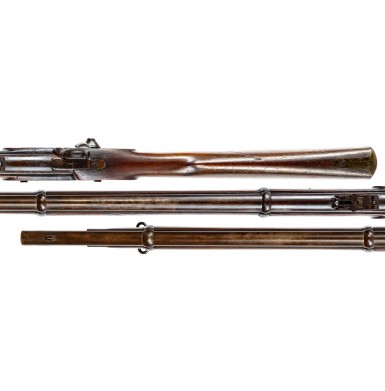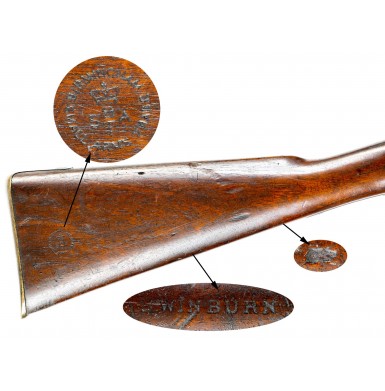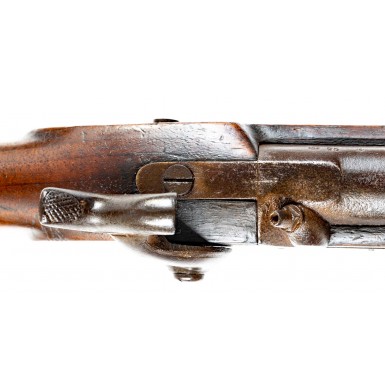Crisp, Attic & Untouched Pattern 1853 Enfield by Swinburn & Son
- Product Code: FLA-3703-SOLD
- Availability: Out Of Stock
-
$1.00
The Pattern 1853 “Enfield” Rifle Musket was the second most used infantry long arm of the American Civil War. The Pattern 1853 Enfield was an important weapon in military long arm history as it was the first “small bore” rifled long arm to see general issue to all British military personnel, effectively making every soldier a “rifleman” and eliminating both the smoothbore musket and the large caliber “Minié Rifle” as legitimate battlefield weapons. The reduced caliber .577” bore was a significant ballistic improvement over the .702” bore of the Pattern 1851 Minié Rifle and the overall design of the gun was the epitome of muzzle loading military firearms technology of the time. The P1853 would significantly influence the design of the new American Model 1855 Rifle Musket (as well as its subsequent replacements the M1861, Special Model 1861 and M1863/64) and would be the last of the percussion ignition, muzzleloading arms to see general service with the British military, being replaced by breechloading rifles about the time the American Civil War came to an end.
The P1853 was so revolutionary and so well designed that the “Enfield” was effectively the “AK-47” of the era, becoming the either the standard battle rifle for nearly every country in the world, or an equivalent “substitute standard” for those countries that selected another model as their standard issue rifle musket. Several million “Enfields” saw use across the globe during mid-19th century, so it is often difficult to determine if a specific Enfield rifle or rifle musket was exported for use the American Civil War, especially in the absence of specific US or CS markings on the gun. However, with somewhere in the neighborhood of one million Enfields being purchased and used by both sides combined during the course of the war, the very fact that a commercially made Pattern 1853 Enfield Rifle Musket that is devoid of any British military or colonial marks is in the United States suggests that the gun may well be a veteran of that horrible conflict
This Pattern 1853 Type III Enfield Rifle Musket is in ATTIC FINE condition and is a classic example of the typical Civil War imported Enfield rifle musket. The gun is devoid of any British military markings and is a typical Birmingham made contract gun for commercial sale that was almost certainly destined for export. As a Birmingham produced gun it is also a wonderful example of the way the Birmingham Small Arms Trade worked during the mid-19th century with a master contractor assembling the gun from a variety of components made not only by himself but by other B.S.A.T. members. In this case the master contractor was Swinburn & Sons and is clearly stamped with the SWINBURN name along the toe line of the stock, behind the triggerguard. Additional Swinburn worker marks are found throughout the gun with a S&S 27 mark in the ramrod channel of the gun and an S&S 45 mark at the rear edge of the stock’s counterpane. Both of these are Swinburn worker marks, with #27 likely being the stock maker or stocker and #45 being the “setter up” who assembled the gun.
The firm of Swinburn & Son had its origin in the 1832 partnership between John Field and Charles Philip Swinburn. After John Field passed away in 1834, C.P. Swinburn succeeded to the business at 15 Newtown Row, moving to 14 Weaman Row in St. Mary’s in 1838 and eventually to 17 Russell Street in 1840, where the firm remained until it went out of business in 1883. In 1850 the firm expanded to include #16 Russell Street as well and also added a 14 Weaman Row address, likely as a retail location, in 1853. In 1851, the firm became Swinburn & Son with the addition of C.P. Swinburn’s son to the business, who he had named John Field Swinburn in honor of his old partner. John Field Swinburn would be granted a number of British firearms patents during his working career, including #2625/1857 for a “lock mechanism” and #2269/1858 for a barrel band that was utilized on the double barreled Jacob’s Rifle. Swinburn & Son also produced the Jacob’s patent rifles. During the post-Civil War era J.F. Swinburn received at least eleven patents, primarily for breechloading arms and action mechanisms. C.P. Swinburn was one of the founding members of the Birmingham Small Arms Trade gunmakers association as well as a founding member of the Birmingham Small Arms Trade LTD manufacturing company, holding 110 of the 2,000 initial shares of the business, or 5.5%, making him one of the largest single investors in the company. An 1841 advertisement for the firm read in part:
C.P. SWINBURN (Successor to J. Field)
Gun and Pistol Maker to Her Majesty’s Honourable Board of Ordnance
Manufacturers of Fire Arms, Fine Fowling Pieces, Rifles & Pistols
Gun Barrels, Locks & Furniture, Sportsmen’s Implements, & c. of every description,
and upon the most approved principle.
No. 17 Russell Street, Birmingham
The lock of the gun is clearly marked with the typical British “Crown” to the rear of the hammer, but without the accompanying “VR” underneath that normally denotes British government ownership. The lock is marked 1863 / TOWER forward of the hammer. The interior of the lock is marked M&P over the mainspring as well as CPS for CP Swinburn. The lock maker’s mark found at the mainspring boss are the initials I&EP, which likely represent the Birmingham firm of Edwin & Isaiah Parkes. The assembly mating mark \ \ / is found on the top edge of the lock and is also found on all of the major components, including under the barrel and in the ramrod channel of the stock. The barrel is marked at the breech with the three usual Birmingham commercial proofs; a Provisional Proof, a Definitive Proof and a Definitive View mark. These marks are separated by a pair of 25 gauge marks, indicating that the gun is “25 bore” or .577 caliber. The underside of the barrel bears the mark of Birmingham gun and barrel maker Thomas Turner, and is stamped T TURNER. Turner and J.F. Swinburn would enter a lucrative gunmaking partnership in the post-Civil War period. The barrel and breech plug are both marked with the matching mating number 1334 and the matching mating mark \ \ / is present as well. The ramrod channel of the stock appears to read JP COLE and is marked with file slash assembly mark found elsewhere on the gun as well as the Swinburn worker’s mark mentioned above. Cole, who may have been the stock maker, is not listed in any of my references.
As noted, the gun is in ATTIC FINE condition overall and is quite crisp and untouched. The gun appears to be 100% original, complete and correct, with nearly every part that has a mating mark displaying the expected file slashes. The gun retains none of its original rust blued finish on the exterior of the barrel, apparently having been “Struck Bright,” likely during the period of use or immediately thereafter. When firms like Schuyler, Hartley & Graham sold surplus Civil War Enfields in the post-war era, they were often listed as either being “blued” or “bright”, suggesting that not only were some actually struck bright in the field by Union regiments, but that guns in need of refurbishment prior to sale were often brightened with the remaining blue removed, rather than refinished. The exposed metal has a thickly oxidized and untouched brown patina, with even light pitting around the breech area and extending to the base of the rear sight. The balance of the barrel is much smoother, with a slightly more mottled brownish patina and showing scattered minor surface roughness, as well as some pinpricking and scattered light pitting. The bottom of the barrel where it has been protected by the stock has a mostly medium pewter gray patina with some streaky patches of thin original blue. The bore of the gun is in about GOOD condition. The bore is heavily oxidized with even light to moderate pitting along its length and weak visible rifling. An aggressive cleaning might improve the bore and reveal more and crisper rifling. The lock of the gun has a mottled moderately oxidized brown and gray patina with flecks and patches of even darker metal, some patches of rougher surface oxidation, and some more active surface oxidation with an orange-brown color that has been treated with some oil to retard any metal deterioration. The interior of the lock retains mintues traces of case coloring with some weak blue on the internal part. The lock is very good mechanically and functions exactly as it should on all positions. The gun retains its complete and original rear sight, as well as the original combination front sight and socket bayonet lug. The rear sight is weakly marked W&S, indicating production by the famous Birmingham gunmaker Philip Webley & Son. During the Civil War period Webley produced a large number of rear sights that saw use on Pattern 1853 Enfield Rifle Muskets. The gun retains both original sling swivels, one on the front of the brass triggerguard and the other on the tension screw for the upper barrel band. The original screw retention “doughnuts” are present on all three of the barrel band tension screws, a tiny part that is often missing from an Enfield when it is found today. The original full-length ramrod is in the channel under the barrel and retains good threads at the end. The brass furniture has thick, dark patina that is almost black in some areas and matches the condition of the balance of the gun perfectly. The dark brass is very attractive. The stock is in FINE condition. The wood to metal fit of the gun is wonderfully executed throughout, with no slop or gapping present. The stock is full-length, solid and free of any breaks, cracks or repairs. The stock has a really attractive dark, uncleaned brown color with some reddish tones and an attractive grain. The stock retains extremely sharp lines throughout and equally crisp edges and shows no indication of having been sanded. The stock does not even appear to have been cleaned. The stock does show a number of scattered bumps, dings, scuff, scrapes and some minor dents in the wood, as would be expected from a more than 150-year-old military musket but remains extremely crisp and sharp overall.
Overall, this is really fantastic example of a Civil War era Swinburn & Son produced Pattern 1853 Enfield Rifle Musket. Despite the lack of bluing, the gun has the great totally untouched and uncleaned appearance. The gun has tons of eye appeal because of the thick patina and is so much crisper and sharper than most Enfields offered for sale these days that the difference is clearly obvious. If you have been waiting to add a really nice example of a Civil War era Enfield to your collection, now is your chance to get a very nice, “no apologies” gun that you will be very pleased to own and display.
SOLD
Tags: Crisp, Attic, Untouched, Pattern, 1853, Enfield, by, Swinburn, Son














